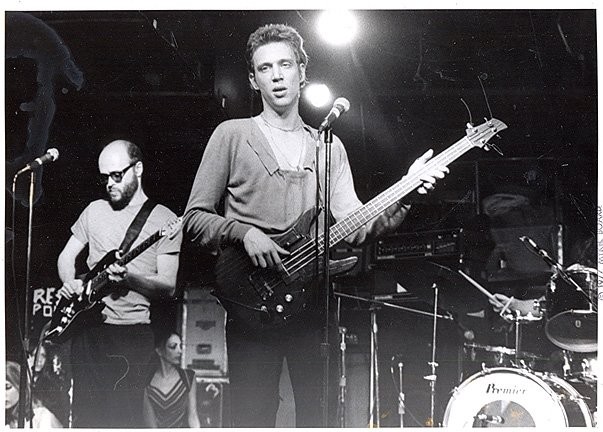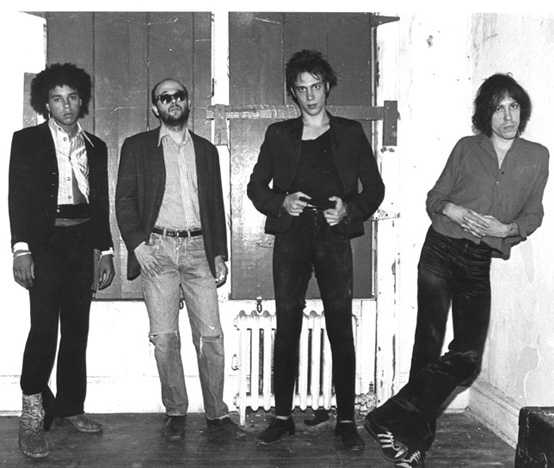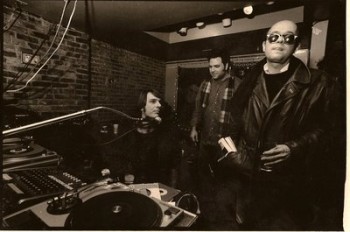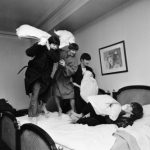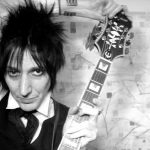This post from 2010 has been ringing up a few hits lately… Thought I’d make it easier for you by moving it to the top of the heap (and making a few minor edits).
My cousin Robert Quine was a bona fide guitar hero (number 80 on Rolling Stone’s list of “The 100 Greatest Guitarists of All Time” – right after Cliff Gallup of Be Bop a Lula fame and before Derek Trucks). But I wasn’t aware of his playing until a couple of years after he blasted his way into New York City’s vibrant punk scene with Blank Generation by Richard Hell and the Voidoids: Blank Generation
In the liner notes to Spurts: The Richard Hell Story, a very thoughtful Hell had (hath?) this to say about what you just heard: “It sounds to me like the solo is coming from another dimension. I don’t know if it has any relationship to anything in history. Though of course everything does, and that solo specifically refers to certain records Quine liked.”
I was raised on jazz, blues and bluegrass music, so punk rock wasn’t something that I naturally embraced. Then a college buddy took me to CBGB in New York’s seedy Bowery area to see The Dead Boys from Cleveland (even though I could’ve driven a couple of miles from my mom’s house in Akron to see them at the Crypt).
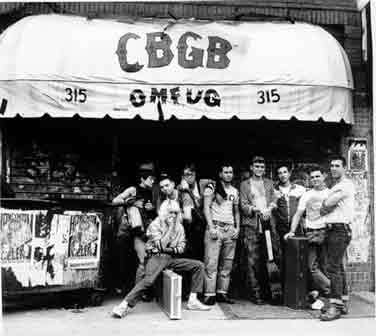 The first thing I noticed when we walked in the club was the disproportionate number of people jammed into the back of the room, by the bar. Meanwhile, a big bouncer separated the “hoi polloi” from the empty VIP section, which was the entire expanse of the club (in other words, about 30 feet) in front of the stage. Must’ve been a showcase gig for a record label. My buddy and I did some quick thinking and convinced the bouncer that we were reporters from some rag back in Ohio, and we grabbed a table up front.
The first thing I noticed when we walked in the club was the disproportionate number of people jammed into the back of the room, by the bar. Meanwhile, a big bouncer separated the “hoi polloi” from the empty VIP section, which was the entire expanse of the club (in other words, about 30 feet) in front of the stage. Must’ve been a showcase gig for a record label. My buddy and I did some quick thinking and convinced the bouncer that we were reporters from some rag back in Ohio, and we grabbed a table up front.
The opening act (name escapes me) made quite an impression when the lead singer tossed his mic over a pipe hanging from the ceiling, pulled the cord back down around his neck, hung himself in the air for a few seconds and then collapsed on stage. That, my friends, is rock ‘n roll! The Dead Boys’ set wasn’t nearly as memorable, although we were invited backstage by a band member’s mom for some birthday cake. I have to say, seeing a middle-aged matron and her friends handing out birthday treats to Stiv Bators and Cheetah Chrome was a surreal experience, especially in that shithole.
But I was glad to visit an American rock shrine, the place where bands like the Voidoids, the Ramones, Patti Smith Group, Television, the Talking Heads and Blondie defined New York City punk and new wave in the late-‘70s.
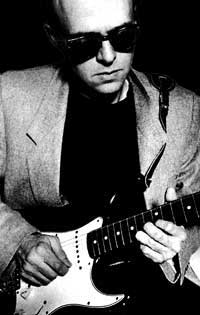 Robert Quine was probably the least-likely rocker of them all. Born in Akron in 1942, he went to a prep school in the area, eventually earned a law degree (from Washington University in St. Louis), and even passed the Missouri bar, but never practiced law. Rob (his parents called him Rob, so I did too… most everyone else called him Quine, which I didn’t for obvious reasons) probably shared a few stray genes with his famous uncle, Willard Van Orman Quine – a brilliant philosopher whose work in analytics and “semantic holism” remains an essential touchstone for deep thinkers around the world. Just don’t ask me what it all means.
Robert Quine was probably the least-likely rocker of them all. Born in Akron in 1942, he went to a prep school in the area, eventually earned a law degree (from Washington University in St. Louis), and even passed the Missouri bar, but never practiced law. Rob (his parents called him Rob, so I did too… most everyone else called him Quine, which I didn’t for obvious reasons) probably shared a few stray genes with his famous uncle, Willard Van Orman Quine – a brilliant philosopher whose work in analytics and “semantic holism” remains an essential touchstone for deep thinkers around the world. Just don’t ask me what it all means.
Rob moved to San Francisco in 1969, where he first met Lou Reed while taping a gig by Reed’s influential band The Velvet Underground. Rob was obsessed with the band, and his tapes of several performances in the Bay Area and at Washington University were released in 2001 as a 3-CD set called Bootleg Series, Vol. 1: The Quine Tapes.
He landed in New York City in ’71, where he wrote tax law treatises for a publishing company, worked at a film memorabilia shop and eventually fell in with a rag-tag group of downtown musicians, like fellow guitarist Tom Verlaine (Television) and Richard Hell. Then Blank Generation set the stage for Rob’s strange musical odyssey, which included studio work for Tom Waits, Marianne Faithfull, Matthew Sweet, avant-gardist John Zorn, R&B legend Andre Williams, and many others.
Someone once described him as looking like a “deranged accountant,” which pretty much nailed it. He usually wore a sport jacket and almost always wore shades, even indoors. And he was quite a bit older than most of the folks he played with (although Reed also was born in ’42).
I never saw Rob play live, but I visited with him several times at his parents’ house in West Akron. His dad, Bob, and mom, Rosalie, were good friends of my parents and also were close with my sister Mary and her husband, Chuck, who lived a block away from the Quines. Bob had inherited his father Cloyd’s business, Akron Equipment (mostly tire molds), but he apparently had little enthusiasm for management and especially the brutal realities of labor relations. He retired at the first opportunity and spent the next 30 or so years of his life traveling the world with his charming and colorful wife Rosalie (she grew up in the Coney Island neighborhood of Brooklyn and claimed to have been a card-carrying member of the Communist Party in her younger days, which seems almost quaint today when you consider the horrors of Al-Qaeda and ISIS).
By the time I met Rob, the Voidoids had already imploded and he’d gained greater notice as Lou Reed’s guitarist. Critics fawned over Rob’s solos on The Blue Mask, which was widely viewed as a return to form for Reed after years of abusing various substances. Although I can’t say that Mask is one of my personal favorites, I’ll admit that anyone who records a solo like this has balls of steel (Rob claimed that Reed annoyed him so much in the studio that he could barely contain himself when they rolled the tape on this one): Waves of Fear
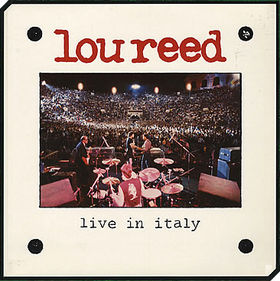 Rob recorded two more albums with Reed – Legendary Hearts and Live in Italy – before he left due to differences that were probably personal as well as musical. He told me the record company sent a test pressing of Legendary Hearts to his parents’ house in Akron, and he was so infuriated with the final mix (some of his guitar parts were mixed out altogether) that he grabbed a hammer, walked out on the driveway and smashed the record into little pieces.
Rob recorded two more albums with Reed – Legendary Hearts and Live in Italy – before he left due to differences that were probably personal as well as musical. He told me the record company sent a test pressing of Legendary Hearts to his parents’ house in Akron, and he was so infuriated with the final mix (some of his guitar parts were mixed out altogether) that he grabbed a hammer, walked out on the driveway and smashed the record into little pieces.
Rob would spend a couple weeks in Akron every year, mainly to decompress and get away from the indignities of life in New York’s Lower East Side, back when squatters and drug dealers were taking over empty buildings (he said he was mugged twice just taking out the garbage).
Rob’s social skills were somewhat lacking, to put it kindly. Rosalie would invite us over, but I think Rob would’ve been perfectly content spending his time in Akron without seeing a soul other than his parents. He would barely acknowledge my presence when I first showed up, then when he realized I wasn’t leaving right away, he’d reluctantly engage in a little conversation – mostly quick responses to my questions about his guitar playing and influences.
But once he decided I actually knew what I was talking about, we were off and running. His stories (like the driveway incident) could be hugely entertaining, and he had a wonderful way of describing other artists – his rants about Lou Reed were priceless – and the recordings that really inspired him.
I was surprised to find out he had a jazzman’s sensibility and a deep, heartfelt appreciation of the blues. He actually took a few lessons from the great jazz guitarist Jimmy Raney, whose work with Stan Getz alone was enough to make him a legend. And you can hear a little of that jazz influence in Rob’s later recordings with Zorn, drummer Fred Maher and percussionist Ikue Mori. Here’s a cut from Painted Desert, Rob’s 1997 collaboration with Mori: El Dorado
Rob’s first great inspiration, though, was the country-influenced string-bender James Burton, who made Ricky Nelson’s rockabilly sides far more legitimate than they should have been and eventually settled into a comfortable living as Elvis Presley’s main guitarist. Although he seldom played it straight, Rob seems to pay tribute to Burton in this strangled solo from Reed’s Live in Italy: Betrayed
Rob told me he had a blues radio show when he was at Earlham College in Richmond, Indiana, and one of his favorites was Clarence “Gatemouth” Brown. He also loved Jimmy Reed – which I also found surprising, given Rob’s shrieking, atonal solos with the Voidoids and the other Reed. On another occasion, he asked me if I’d heard of Ted Hawkins, the former street musician from Venice Beach whose warm, soulful voice seemed to convey a world of sadness. Once again, I was floored… Is this the same guy who shredded his way through Love Comes in Spurts?
During one of Rob’s visits to the Rubber City, my sister Mary and I stopped by and asked him if he wanted to head up to Kent with us to see the legendary 15-60-75 (aka The Numbers Band). I could probably spend the next 12 paragraphs or so trying to describe the Kidney Brothers and their amazing legacy in Northeast Ohio. But if I had to offer a brief description of their four-decade career, I’d say they play highly original, somewhat eccentric and often frighteningly intense blues-based music – basically street poetry for rubber rats. Here’s a little taste, recorded live in ’75 at the Cleveland Agora when the Numbers opened for Bob Marley during his first American tour: About Leaving Day
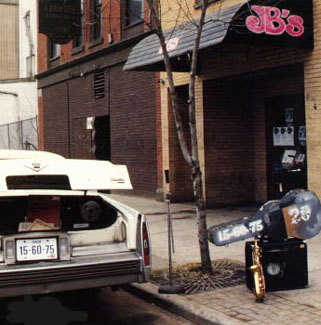 Back to Rob and our invite… he threw us another curve by agreeing to go. We strolled into the Numbers’ main home, JB’s, which smelled a lot like Marley’s dressing room, and stood near the stage to watch an especially riveting set. I thought their guitarist, Michael Stacey, would recognize Rob – his playing seemed to have that punk-rock edge to it. But Rob went mostly unnoticed… although he kept glancing over his shoulder (with shades on, of course) in an odd kind of way, like he was expecting some crazed Kent State student to jump on his back and start pummeling him. Just when I thought we should whisk him back to the security of his parents’ house, he admitted that he enjoyed the band and really appreciated us dragging him along.
Back to Rob and our invite… he threw us another curve by agreeing to go. We strolled into the Numbers’ main home, JB’s, which smelled a lot like Marley’s dressing room, and stood near the stage to watch an especially riveting set. I thought their guitarist, Michael Stacey, would recognize Rob – his playing seemed to have that punk-rock edge to it. But Rob went mostly unnoticed… although he kept glancing over his shoulder (with shades on, of course) in an odd kind of way, like he was expecting some crazed Kent State student to jump on his back and start pummeling him. Just when I thought we should whisk him back to the security of his parents’ house, he admitted that he enjoyed the band and really appreciated us dragging him along.
The last time I saw Rob was after his father passed away – probably around ’99. By then, he’d married a lovely woman named Alice, who was everything socially that Rob wasn’t. She appeared to be his complete support system, which Rob sorely needed given his paranoid nature and darker tendencies. He had just bought the complete Columbia studio recordings of the Miles Davis Quintet, which was playing in the background. “What do you think of this?” he asked. I told him I was working my way through it too and loved virtually everything Miles recorded in the Sixties. He nodded quietly, way beyond the point of being phased by our shared tastes in music.
In 2003, Alice died suddenly at their Soho loft (for an intense account of this event and others involving Rob, check out this piece by The Hound – probably Rob’s closest friend when he was living in NYC). Without Alice’s love and support, Rob went into a tailspin, and he died from a heroin overdose less than a year later.
Rob is conspicuously absent from the Rock ‘n Roll Hall of Fame, which probably suits him just fine. But he remains a major influence on younger musicians like my nephew Dan, who once took the short walk to Bob and Rosalie’s with guitars in hand to jam with Rob.
Dan Auerbach on Robert Quine… “Pat (Carney) and I had just formed The Black Keys and signed a deal with Fat Possum. Meanwhile, my dad browbeat Rosalie into letting me stop by to meet Rob, who begrudgingly agreed to do it. I’m sure he was expecting a high school kid with a shredder guitar and a Limp Bizkit CD. Then I showed up with a couple of Japanese Teisco Del Reys and some stuff by Junior Kimbrough and T-Model Ford. He walked out of a really dark study, with his shades on, and complained that he had a hangover and a headache – could’ve been in withdrawal – but once he saw those guitars he took off his shades and his eyes lit up right away.
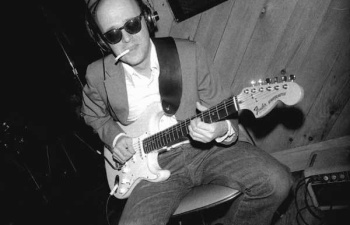 “I played him All Night Long by Junior, who he’d never heard of, and he was completely blown away. Then we talked for a couple of hours about music and even noodled around on guitar together. He told me everything he did was just a variation on Chuck Berry. He also spoke fondly of (guitarist) Marc Ribot… said he was very grateful for all the gigs that Ribot lined up for him. Of course, Pat and I later brought Marc in to play on Attack and Release, along with Pat’s uncle Ralph.” Ralph Carney and Robert Quine played together on Tom Waits’ classic album, Rain Dogs (along with Keith Richards) – an unusual connection with The Black Keys that’s rarely mentioned.
“I played him All Night Long by Junior, who he’d never heard of, and he was completely blown away. Then we talked for a couple of hours about music and even noodled around on guitar together. He told me everything he did was just a variation on Chuck Berry. He also spoke fondly of (guitarist) Marc Ribot… said he was very grateful for all the gigs that Ribot lined up for him. Of course, Pat and I later brought Marc in to play on Attack and Release, along with Pat’s uncle Ralph.” Ralph Carney and Robert Quine played together on Tom Waits’ classic album, Rain Dogs (along with Keith Richards) – an unusual connection with The Black Keys that’s rarely mentioned.
“Robert used a Peavey solid-state amp [Dan prefers tube amps], which made sense when you consider the sound he became known for at times – so jagged and in your face. A lot of punk-rockers’ guitar playing came across as ‘fake’ aggression… Robert had the ability to be atmospheric and airy or aggressive and edgy but in a ‘real’ way… and in a style that became all his own. Probably all that pent-up rage from getting sent off to prep school by his parents!”
They got together again after that, and Rob encouraged Dan to look him up in New York City. “He said he’d always been in the phone book – spelled ‘Kwine.'” But Dan never had the opportunity. “We had our first sold-out show in New York in 2004, I think it was at the Roseland Ballroom, and I was really looking forward to having him at the show. But he passed away right before we hit town.”
One of the tragic realities of Rob’s passing is that he never had an opportunity to collaborate with Dan in the studio. But Marc Ribot’s biting guitar on Oceans & Streams gives us a sense of what could have been: Oceans & Streams
Robert Quine on video… Nasty guitar solo from a night with Lou Reed, 1983. Lou could’ve spent a little more time working on that Clint Eastwood impersonation.



